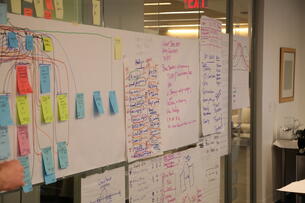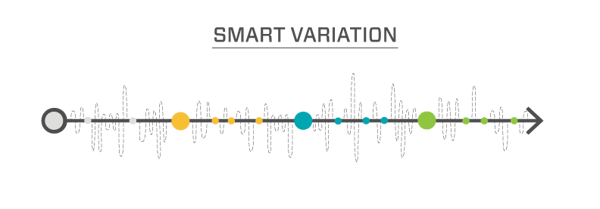Authored by Jonathan Bykowski and Laura Silvoy.
In March, ten leaders representing a cross section of the firm dedicated three days to uncovering the reality about how a project moves from client request to a finished building, developing an improved solution and deciding how to advance the firm from our current operations to the ideal future.
This year, our continuous improvement department suggested using a Value Stream Mapping (VSM) Event as a leadership retreat. Some members of the Board were hesitant, but put faith in the recommendation. Past retreats brought the entire leadership team together to discuss company goals and directions. The VSM Event limited the team to ten individuals representing the full spectrum of project roles. Working together, they sought a way to improve project delivery and value while instilling a culture of continuous improvement.
We may be performing well, but we want to be better and really understand what it means to be outstanding.
JONATHAN BYKOWSKI, PRACTICE LEADER, CONTINUOUS IMPROVEMENT
Three major phases compose the entirety of the VSM Event. This activity begins with the creation and socialization of the Project Charter. First, the executive sponsor, value stream champion and facilitator develop the Charter. After completing the Charter, it is socialized so that everyone in the firm understands the goals of the event. Questions and comments surrounding the Charter are collected for the mapping team.

The next major milestone is the three-day mapping activity. Data and facts are vital on the first day as the team dissects the current state. Innovation and creativity reign on the second day, when the ideal future state is developed. Rigor and dedication drive the creation of the transformation plan on the third and final day.
Implementing the transformation plan is the final major event. Once everyone packs up their bags from three intense days, it is up to the mapping team to disseminate information firm-wide and engage everyone in the improvement that must follow.
The mapping activity resulted in three deliverables: a current state map, a future state map and a transformation plan. The value of the deliverables is far exceeded by the significance of the conversations and the alignment that occurred during the event. Sequestering a team of leaders for three days with a knowledgeable facilitator resulted in powerful knowledge exchange and decision-making. To ensure exceptional project delivery and value, three themes surfaced as future state goals during current state mapping: standardization, technical alignment and the need for a common thread.
A knowledge-based industry tends to shy away from the idea of standardization. Every client, site and existing condition is different, so how could we deliver customized work with a standard process? Good variation accompanied by strategic standardization is the key in our creative industry.

Developing standard work for processes that don’t require intense creative thinking, such as invoicing, or even life safety plans, enables our designers and planners to spend time on good variation, such as the creative activities that require iteration. Our clients will recognize the benefit of standard work in the custom designs developed around their specific needs and requests.
During each phase of our approach, we recognize the importance of utilizing the right tool at the right time. As we constantly strive to improve our delivery process, the appropriate application of tools during design is always being challenged. We can bring immeasurable value to our clients by examining the technical alignment of our project delivery. Developing a standard format involving the most germane tools for collecting and disseminating data throughout the design process will allow project teams to work swiftly and accurately. Here, there is great value in both standardization and technical alignment across the organization.
Our staff is dedicated to their projects, providing advice and serving as a liaison to clients throughout the duration of a design. Understandably, the client establishes a deep connection with the individuals who helped them realize the goals and atmosphere of their new space. Due to their early involvement in a project, many times our planners become the face of Array and are unable to make a smooth transition to a new project when the time is right. Our teams include a variety of content experts who each contribute to our projects’ successes.
We believe one of these individuals must become the go-to person throughout the duration of the project, allowing our planners and architectural designers to perform their obligations and transition to the next project. A single point-of-contact provides value to our clients in two specific ways. First, the client will know exactly whom to contact if an issue arises. Second, everyone involved in the project will be working specifically in their field of expertise, allowing for better design and more consistent delivery. This new role weaves together the art and craft of what we do with the service and business our clients expect.
The three themes of standardization, technical alignment and the need for a common thread are clearly reflected in the resulting transformation plan. Now, the leaders who developed a strategy for improving the value of our project delivery will champion the changes. Each leader took on at least one project; and will work closely with employees from all levels of the organization to make lasting improvements. Through their ongoing participation, our leaders demonstrated their dedication to improvement efforts across the firm, resulting in a culture committed to continually improving our project delivery and the value we provide to our clients.

